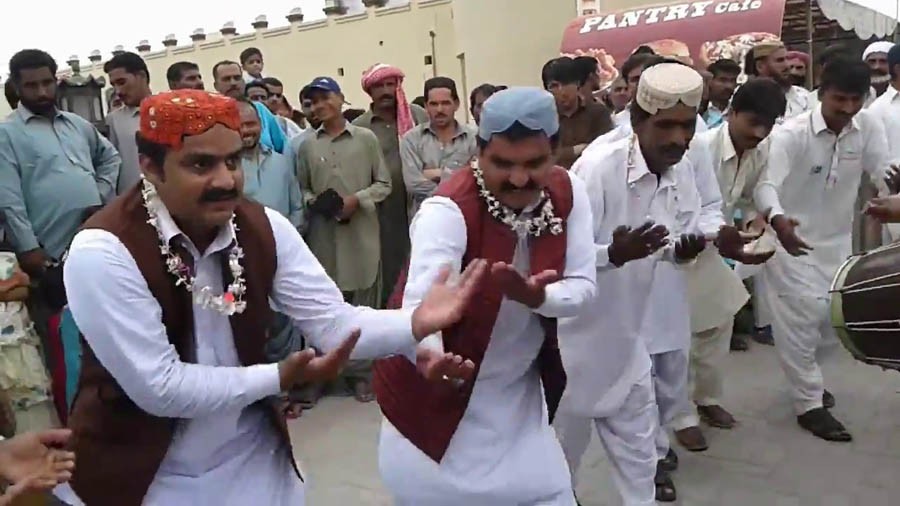
Culture always supports or forms the bedrock of political separateness

It was refreshing to see the culture of Dera Ghazi Khan being celebrated in the premises of Alhamra Arts Council, Lahore, recently. There was a time in Pakistan when identifying and celebrating the culture of a province or an area was considered to be challenging the very idea of a homogeneous state.
It is another matter that the current chief minister of the Punjab hails from the same area, and probably the event was held as a gesture of appreciation and gratitude. Jhoomar (a folk dance) and sword dances were performed by various artists, including Taj Baledi, Mohammad Ali Mazari, Umer Buzdar, Qasim Siri and Owais Pathan Khan. It was supposed to be a promo to another festival due in Fort Munro next month - the Koh-e-Suleman Tourist Festival 2019 - which will promote tourism in Koh-e-Suleman as well as other mountainous areas such as Hak Bai, Mubaraki Top, Bail Pathar, Barthi, and Anari Hills.
But let us not think only in negative terms. It is commendable that an area as neglected as Dera Ghazi Khan can be seen to be rich in its cultural expression, be it singing or dancing. One is more aware of their famous poets than their performing artistes.
In the early years of the country, expressions of culture differed greatly in the eastern and western wings. And the Bengali assertion of their cultural values were looked at askance by the growing body of hardliners in the western wing. The eastern wing’s narrative was seen at variance by the so-called custodians of homogeneity. The two were poised against each other and it was not seen as something dialectical or that did not necessarily mean a binary other.
Some of the edge was perceived to have been blunted by that section with the creation of One Unit in the mid-1950s. Pakistan had come into existence with the decision of the legislatures of Punjab, Sindh, and Bengal to be made into an independent federation, so the thinking prevailed that individual unities or flavours of the various regions were meant to flow into the making of the cultural matrix of the new state. But there was another strain that wanted a decisive break with the post-colonial era, and whatever went into the making of the new country was to be left at the threshold of 1947, and a new beginning was to be made. It was to wipe clean the slate and start inscribing on it. This new beginning, meaning a break from the past, excited a few who wanted to engineer the relationship of nationhood with statehood, and the role culture was supposed to play in it.
This fabrication and break with the past in a wholesome manner, if it can be done and is possible, suited those who were having problems with the two fundamental challenges facing the new country -- the relation of the federating units with the federation, and the role of religion in running the affairs of the state. The overlay of a unified concept of a state, and the imposition of a single narrative regarding statehood, suited the fabricators and those who wanted to create everything anew, which had little to do with the continuation of traditions, customs, attitudes, and even ritual and social institutions. But we all know what came out of the drive to impose a unified statehood as the country unfortunately, but predictably, broke into two.
And yet again, with the toppling of Zulfikar Ali Bhutto’s government and imposition of another straitjacket military order, the Sindhis started to assert themselves not only politically but also through their culture. Their cultural expression was supported from the top while their politics was not, and there was encouragement for the two to be seen as separate entities.
The Punjabis have often been accused of playing the one-country card to the exclusion of others and their aspirations. The Sindhi assertion, particularly when it was seen working in favour of the separation of politics from culture, was encouraged. It was good for the Sindhis to be singing the wais and kafis, and whirling to the Soong fakirs but bad if found looking for a relationship, with politics.
Things may have changed. In recent years, it is not only the Baloch and the Pashtun who assert the individuality of their cultures, but also various sections within Punjab that call for identification on their own terms rather than the subsuming Punjabi identity or culture.
In the past many years, the culture of Cholistan has been celebrated in the heart of Lahore -- that is, at Alhamra -- and people partake of it without, at any time, feeling it is being pitched against theirs or that their own cultural concepts are being challenged or belittled.
All said and done, the two-day event at Alhamra on the culture of Dera Ghazi Khan was a welcome move. This has been given more poignancy since the talk of dividing the Punjab into Saraiki area and the rest. People have become more aware of the distinctions and that has to translate into a political demand. It is always culture that supports or forms the bedrock of political separateness and not the other way round, for then it will be social engineering of the worst kind.